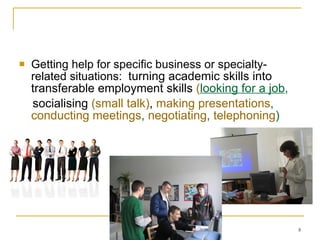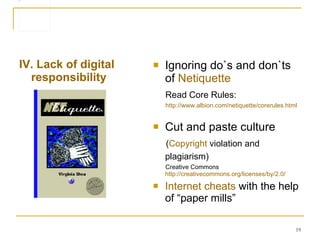Technology friend foe
- 1. Technology: A Friend or A Foe ? Ene Peterson Virumaa College of Tallinn University of Technology [email_address]
- 2. Things aren't what they used to be T ypical student-centered 21st century classroom s A typical teacher-centered classroom in the 1960`s
- 3. A N ew G eneration of S tudents
- 4. Digital N atives vs D igital I mmigrants
- 5. Teaching digital natives http://www.youtube.com/watch?v=uEDulInv9rE 21st Century Learning - Digital Learners 21st Century Learning - Tomorrow's Teachers http://www.youtube.com/watch?v=eHSv_RFm23g&feature=related
- 6. Dreams coming true ...
- 7. Benefits of Implementing Technology in the Language Classroom Access to authentic websites, online reference tools ( online dictionaries , thesauri (incl visual thesauri ), encyclopedias , spell-checkers , concordances (words in their natural contexts) Web Concordancer has searched corpus http://www.edict.com.hk/scripts/cgi-bin/Wwwconcgram.exe
- 8. Getting help for specific business or specialty -related situations: t urning academic skills into transferable employment skills ( looking for a job , socialising ( small talk ) , making presentations , conducting meetings , negotiating , telephoning )
- 9. Enhanced possibilities for synchronous (chat, skype, instant messenger, audio/ web conferencing) and asynchronous (email, email discussion groups , e-mail pals , texting (SMS), discussion boards, blogs, dialogue journals) communication .
- 10. Develop listening ( online audio and video news , podcasts , and speaking skills (online webcasts , conferences )
- 11. Internet-based tasks - web quests - short and long-term projects ( The House of my Dreams. A Trip to my Dream Country . My company ) Creating e-portfolio/ digital portfolio
- 12. From 1.0 to Web 2.0 and Web 3Di Second / third generation of web based communities S ocial networking tools âlearning with and from others Collaborating with others ( wikis ) Webvolution http://www.youtube.com/watch?v=-cZTdFTZV5Q
- 13. Technology as a friend The use of technology (âinteractivityâ of language tasks) can be motivating. Learners can proceed at their own space, make their own choices. Learners can get instant feedback on what they have done and personalized assessment. The use of technology in and outside the language classroom can make learners more autonomous.
- 14. Using ICT with learners gives them practice for real-life ICT contexts. It is possible to develop as the receptive (listening and reading) as well as productive skills (writing and speaking) skills via computer-mediated communication. Keeps the teacher and student learning new skills.
- 15. Pitfalls of the use of technology I. Internet security and privacy Cybercrimes from benign spam and cyber slacking to obscene or offensive content, fraud, identity theft, viruses, hacking, cyber stalking âĶ The risks in sharing and collaborating online Useful website: http://www.getnetwise.org/
- 16. II. Lack of information literacy Digital information overload: - how to search for useful material - how to evaluate the appropriateness of resources on the web
- 17. III. In terms of learning The problem of trustworthiness and accuracy of online materials (e.g. translation programs, spell and grammar checkers) ?4U. WAN2 TXT? RU n00b ? TBL or CUL8R .
- 18. My message: I have a question. Want to text? Are you newbie? Text back later or see you later. Hometask:
- 19. I V . Lack of digital responsibility Ignoring do`s and don`ts of Netiquette Read Core Rules: http ://www.albion.com/netiquette/corerules.html C ut and paste culture ( Copyright violation an d plagiarism ) Creative Commons http://creativecommons.org/licenses/by/2.0/ Internet cheats with the help of âpaper millsâ
- 20. Summary Technology is both a friend and a foe . Technology should fit learner needs â not fit the learner to the technology. Technology is not a panacea that can replace language teachers and F2F classrooms, it is something tha t can be used to enhance language learning ( Sharma & Barrett , Blended Learning ,2008).
- 21. Thank you for attention!
Editor's Notes
- #2: Technology is such an integral part of our lives these days that it is not only much of the time taken for granted, but often it seems we can't even keep up with the latest advances and developments. The aim of this presentation is to deal with some aspects of technology and show what kind of impact has technology had on teaching languages during the last 50 years and find an answer to the question: is technology more our friend than foe in teaching languages ?
- #5: Marc Prensky, An American writer and speaker, is best known as the inventor populaizer of the terms âdigital nativeâ and âdigital immigrantâ which he described in his article in 2001.
- #13: The Web has changed dramatically this decade. Advancements like Web 2.0, Enterprise 2.0, and Cloud Computing have changed both the technology and the online culture of the modern Internet.

![Technology: A Friend or A Foe ? Ene Peterson Virumaa College of Tallinn University of Technology [email_address]](https://image.slidesharecdn.com/technologyfriendfoe-100727044317-phpapp01/85/Technology-friend-foe-1-320.jpg)



















